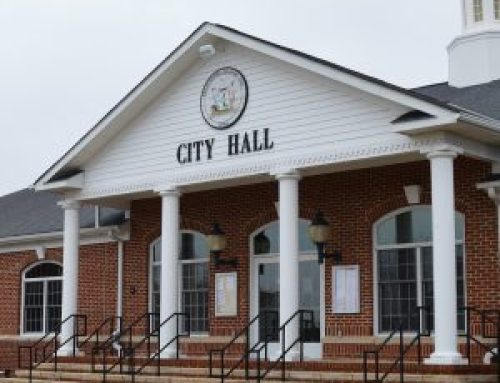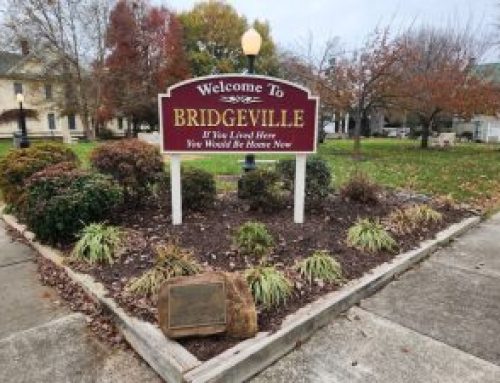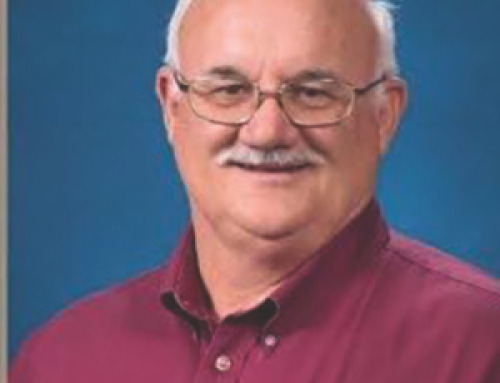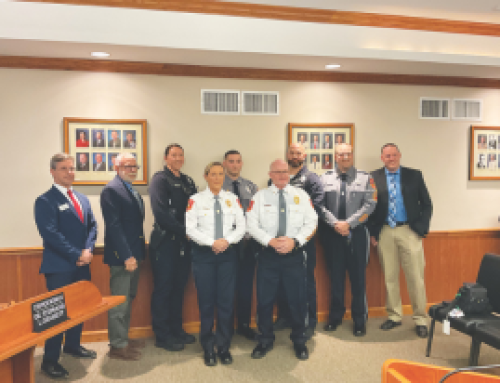By Carol Kinsley
Residents of Blades learned details of a solar farm planned for a nearby wooded area at a meeting held last week at Seaford Fire Hall. Many were concerned because 12 acres of property in town were recently clear cut for a townhouse development.
Whitney Hastings Pogwist served as spokesperson for the owners of 34 acres of woods between the town of Blades and Sussex Highway. She and her cousins inherited the property from their grandfather, Norman E. Hastings, who died in 2003. The property was — is — a tree farm, and the family has waited 22 years to see income from the property.
“The property will be timbered, regardless,” Pogwist said. After investigating options, Pogwist and the family decided leasing the land for a solar field would be easier and less invasive than harvesting the entire plot.

Blades Mayor Nancy McAdams, left, and several town residents examine a display of a proposed solar farm near their homes at a meeting last week at the Seaford Fire Hall. The solar farm would require cutting 17 acres of trees from a 34-acre plot between the town and Sussex Highway. Representatives of ECA Solar told residents they would not even know it was there.
“It was the best way to go rather than develop the property,” she said. “It’s what our family wants to do. Our grandfather left it for the family to prosper, and we’d rather help the community than develop the land.” She continued, “My grandfather sold the land for Little Meadows and they destroyed every tree on it. This is the most beneficial way for the family to prosper without detriment to the property.”
Helping the community of Blades is nothing new to the family. Their grandmother, Norman’s wife, was Margaret Hastings, mayor of Blades from 1946 to 1956, and notably the first female mayor in Delaware.
Pogwist was put in contact with ECA Solar, an employee-owned company based in Waltham, Mass. Founded in 2014, ECA has developed and constructed more than 50 projects in seven states. The company has more than 20 projects in various stages of development in Delaware, including one off Helen’s Lane near Seaford’s Public Works office.
Vincent Moschella, chief development officer, outlined plans for the proposed solar field near Blades.
Of the 34 acres, only 17 will be disturbed. The balance will be untouched. Solar panels will be erected on 10.5 acres; the balance of the 17 acres will be planted with a native seed mix developed specifically for the site with the help of Sussex Conservation District to re-establish wildlife habitat.
“Our goal is to keep every tree we can,” Moschella said. A 60-foot buffer will remain adjacent to Little Meadows.
Stumps will be left in a 10-foot buffer area outside a fenced area to allow regrowth of trees, which will be topped when they reach a certain height.
“We will create mounds of brush for animals,” Moschella added.
The solar field will be enclosed within an eight-foot high knot wire fence such as is used on horse farms, with four-inch by four-inch openings on most of the fence and eight-inch by eight-inch openings elsewhere to allow access for larger wildlife. The fence design was pioneered by ECA, Moschella said. Deer will be excluded. For the first three years, while the meadow is established, a green mesh fabric on the fence will block the view.
The panels will be three feet off the ground. Planted in north-south rows, they will track the sun and will reach a maximum height of 9.5 feet at the earliest part of the morning and end of the day. The meadow mix will be of plants that reach up to three feet in height. The meadow will be mowed only as necessary.
Access will not be from Normandy Lane, which approaches the property, but from Route 13, via extension of an existing driveway between Sussex Printing office and Del-Mar-Va Paving Co., all pending DelDOT approval. Plans call for a 14-foot wide gravel road into the site.
Most of the infrastructure will be underground. Electricity will be routed to wires on six wood poles off Route 13.
“There will be no structures, no batteries, no lights, no energy stored,” Moschella said. “We will have ‘smart inverters’ to change DC to AC.” He added neighbors should see an improvement in power quality. There will also be a system to make sure the voltage is the same as on the street.
A glare study has been done for all neighboring properties, none of which would experience glare from the solar panels. There would be no adverse sound, due to the design. The electrical equipment is centrally located in the middle of the project as the county requires.
A certified wildlife survey will be done by a third party. A preliminary study shows there are no owl or eagle nests that would be affected.
Stormwater will be reduced by the meadow and perhaps a pond or series of swales or filter strips, following the advice of the Conservation District. “We must hold runoff as it is today,” Moscella said.
“We did a shade analysis. We are only cutting what we have to. If new trees in the buffer area get too tall, we will top them. We offset acre for acre with new reforestation. We plan reforestation in the Seaford area. We are taking down trees, but they will be replaced. That best practice management is part of our company culture.”
The solar field could produce enough electricity for about 500 homes, Moschella said. ECA is only allowed to sell electricity to Delmarva Power and Light, and it can’t go out of state. The city of Seaford has its own electric company. “We will hold ‘subscriptions’ open for Blades’ residents,” he continued. “There is no cost to join or leave.”
Bill Andrew, retired CEO of DP&L, said under a plan put together by the state of Delaware, subscribers could get a 10 percent rate reduction (in the form of a credit on their monthly bill). Although this is a small solar facility, it will help support the grid. “Small ones make a difference when there’s a group of them.”
Andrew said he had talked to state representatives at the invitation of Rep. Tim Dukes, and told them the only opportunity (for alternative energy generation) we have in the next five years is solar. Maybe in 10 years…natural gas — new, not a 50-year-old plant. “Solar energy is what we’ve got.”
Moschella noted, “A lot of people can’t have solar. By subscribing, you get a lot of benefits as though you owned the solar panels.” For the four projects currently under construction in Delaware, it took about three months to get enough subscribers, he added.
Pushed for a potential area of service, Andrew Bunnell, ECA’s general counsel, said subscribers would likely live within zip code 19973. A more precise determination would be made within the first 300 days.
The lease is for 30 years. At the end of the lease period, it will be up to the family to decide what happens next. “I have no idea what my kids would do,” Pogwist said.
A decommissioning plan is required by county ordinance and a bond must be posted. The bond must be revisited and renewed every five years. Decommissioning calls for the land to be returned to its normal state.
Asked why the solar farm couldn’t be put over a large parking lot somewhere, Moschella answered “car ports” such as that are very expensive and usually the result of a corporate initiative. “The users pay more for solar electricity than if they got it from the grid,” he said. Allowing for snow plows requires panels to be 16 feet in the air. Steel needs to go 20 feet down, and the project requires an enormous amount of concrete. “It would cost three times what this project will cost. What we’re doing is to save money.”
One resident expressed appreciation: “Thank you and your family for your forward thinking. This is a big improvement from what we have had.”
Pogwist replied, “It’s the best alternative for our family — to prosper from (the land) rather than develop it. This is a long-term journey for us, not a big sack of money.”
Years ago, the property was identified as a future growth site for Blades, although it is not part of the town at present. There are benefits to annexation, such as the number of units per acre, water and sewer, Pogwist noted.
“I have other family members I must answer to. If (this project) is not supported, development may be the next step. My grandfather was into nature and hunting, and he would be so proud of this. If you could support us, it would be appreciated.”
The first of two public hearings on the matter will be held by Sussex County Planning and Zoning in the county chambers building in Georgetown on April 16 at 5 p.m.
A solar farm would be a “conditional use” that would not require a change in zoning for the property, “but the county can add conditions and hold our feet to the fire,” Moschella said.





